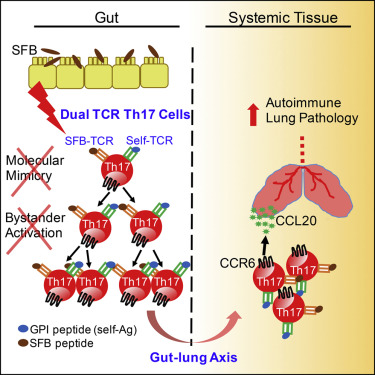Cell Host & Microbe ( IF 20.6 ) Pub Date : 2017-11-08 , DOI: 10.1016/j.chom.2017.10.007 C. Pierce Bradley , Fei Teng , Krysta M. Felix , Teruyuki Sano , Debdut Naskar , Katharine E. Block , Haochu Huang , Kenneth S. Knox , Dan R. Littman , Hsin-Jung Joyce Wu

|
Lung complications are a major cause of rheumatoid arthritis-related mortality. Involvement of gut microbiota in lung diseases by the gut-lung axis has been widely observed, but the underlying mechanism remains mostly unknown. Using an autoimmune arthritis model, we show that a constituent of the gut microbiota, segmented filamentous bacteria (SFB), distantly provoke lung pathology. SFB induce autoantibodies in lung during the pre-arthritic phase, and SFB-dependent lung pathology requires the T helper 17 (Th17) responses. SFB-induced gut Th17 cells are preferentially recruited to lung over spleen due to robust expression in the lung of the Th17 chemoattractant, CCL20. Additionally, we found that in peripheral tissues, SFB selectively expand dual T cell receptor (TCR)-expressing Th17 cells recognizing both an SFB epitope and self-antigen, thus augmenting autoimmunity. This study reveals mechanisms for commensal-mediated gut-lung crosstalk and dual TCR-based autoimmunity.
中文翻译:

分段丝状细菌通过诱导表达双TCRs的肠肺轴Th17细胞引起肺自身免疫。
肺部并发症是类风湿关节炎相关死亡率的主要原因。肠-肺轴参与了肠道微生物群在肺部疾病中的作用,但其潜在机制仍不清楚。使用自身免疫性关节炎模型,我们显示肠道菌群的组成部分,分段的丝状细菌(SFB),远距离激发了肺部病理。SFB在关节炎发作前会在肺中诱导自身抗体,而SFB依赖的肺病理学需要T辅助细胞17(Th17)应答。由于Th17趋化因子CCL20在肺中的强劲表达,SFB诱导的肠道Th17细胞优先于脾脏被募集到肺中。此外,我们发现在外周组织中,SFB选择性地扩展了表达SFB表位和自身抗原的双重T细胞受体(TCR)表达Th17细胞,从而增强自身免疫性。这项研究揭示了共生介导的肠肺串扰和双重基于TCR的自身免疫的机制。











































 京公网安备 11010802027423号
京公网安备 11010802027423号